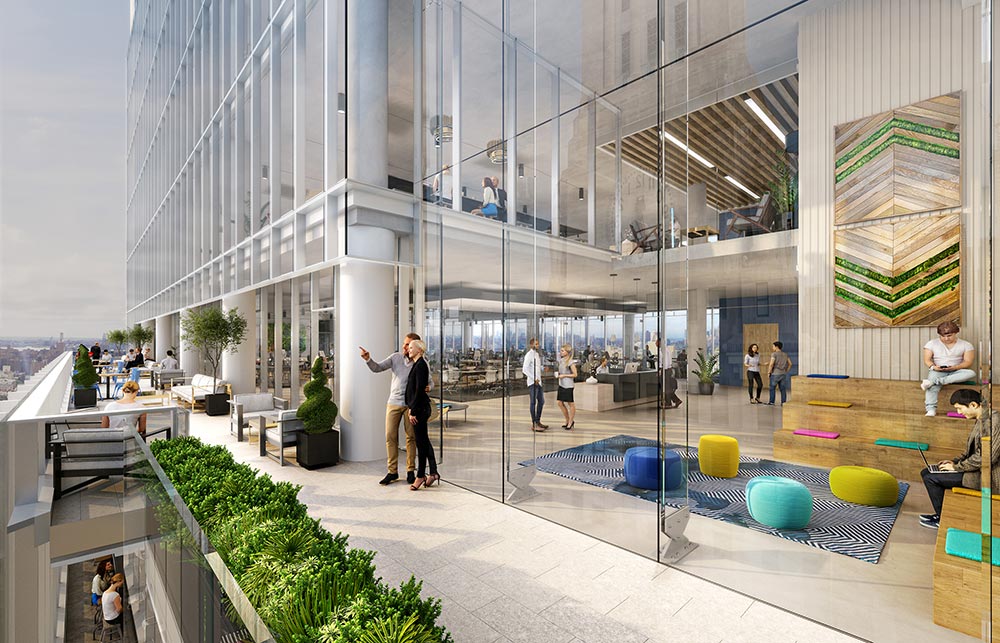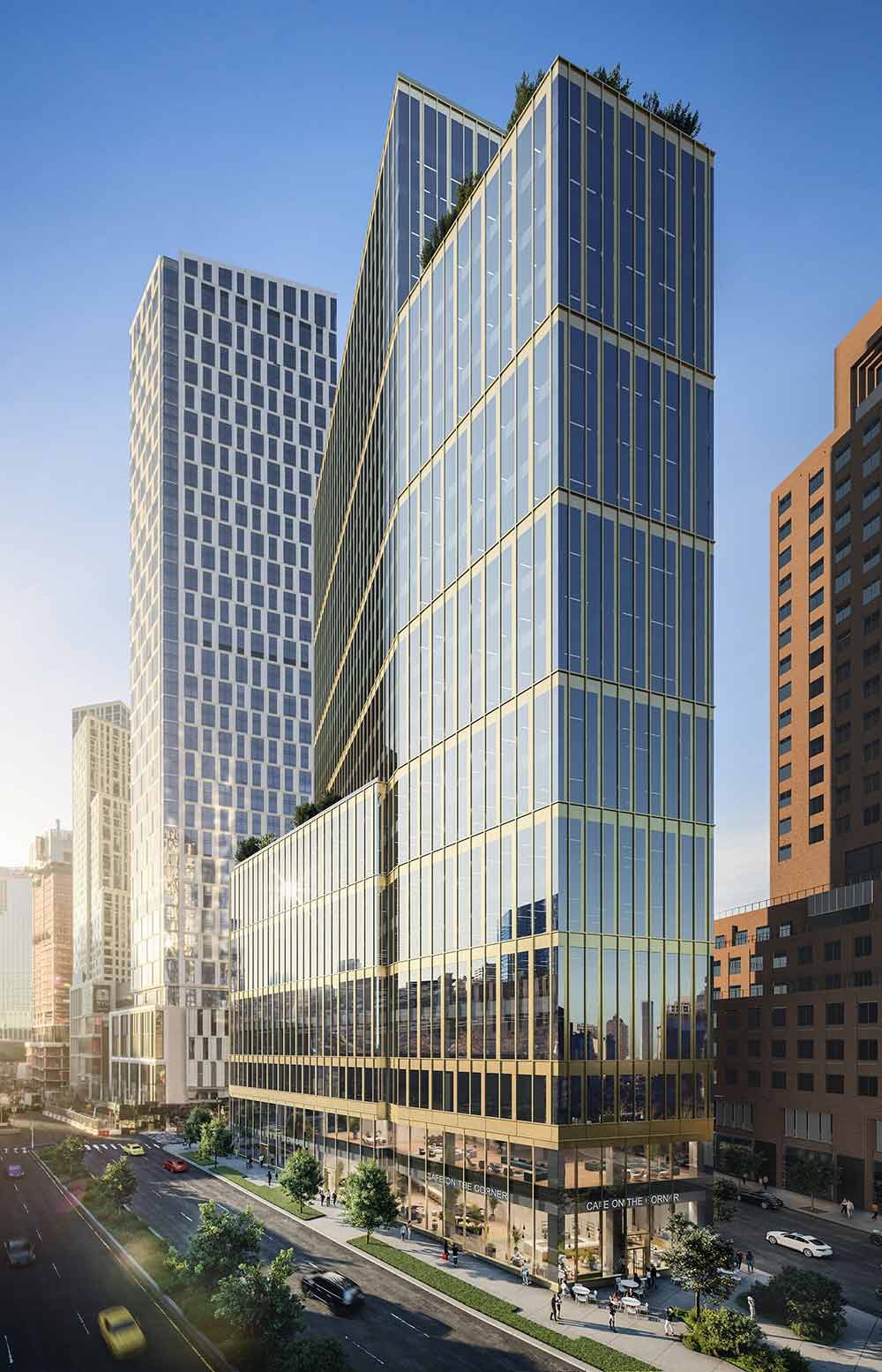当人们习惯了居家办公,办公楼开发商该怎么办
近一年前,各地因为新冠疫情而开始执行封锁措施。随后,数以百万计的美国人被迫放弃通勤,带着办公用品开始居家办公。
之后的情况一直没有太大变化。皮尤研究中心(Pew Research Center)在去年12月的一项调查发现,在大部分工作职责可以在家完成的上班族当中,有71%“全部或大部分时间”依旧在居家办公。另外,有54%表示希望在疫情结束之后继续居家办公。
这给美国各地的建筑开发商带来了一个前所未有的挑战:楼层多达两位数并且配有电梯的密闭塔楼,要如何重新吸引上班族?如何让数以百万计已经习惯了穿着睡衣办公的美国人相信,现在是时候恢复通勤,坐地铁回到办公室去办公呢?
位于纽约市的哥伦比亚地产信托公司(Columbia Property Trust)的租赁与资产管理业务高级副总裁保罗•泰迪表示:“因为疫情,对建筑设施的许多升级改造从疫情之前的锦上添花,现在变成了必不可少的措施。”
人们希望减少接触
许多开发商都变得极其关注细节。毕竟,一想到办公室里一天内聚集的细菌数量,恐怕任何人都会下定决心,永远居家办公。
更糟糕的是,让人们担忧的不止是坐在旁边的同事从体内排出的那些常见的污物。美国疾病与预防控制中心(Centers for Disease Control and Prevention)表示,“接触过带有病毒的表面或物品后,再触摸口、鼻、眼等,就可能感染新冠病毒。”
在人员密集的室内办公楼内,经常接触门把手、照明开关、卫生间洗手盆或马桶的上班族们,自然会为此感到忧心忡忡。
因此,许多新建筑将很快为员工提供从街道到办公桌完全无接触的体验,例如纽约市的Zero Irving。
由RAL Companies & Affiliates公司开发的Zero Irving(下图)定于今年晚些时候开业。这栋建筑配备了最先进的无接触技术,楼内租户能够使用手机应用程序进入大楼。这款应用程序可以打开大楼的电动旋转门,使租户通过自动安全闸机,并通过配有目的层调度系统的电梯前往所在楼层,在这个过程中不需要接触任何物品。

RAL Companies的总裁斯宾塞•莱文说:“这栋建筑为访客提供了一种完全无接触的体验。这不仅有益于保证公共健康,还能够提高建筑的运行效率。”
无接触体验不止局限于入口。在哥伦比亚地产信托(Columbia Property Trust)新开发的办公楼百老汇799号(799 Broadway),除了配备目的层调度电梯以外,所有照明设施以及卫生间的门、洗手槽和马桶均采用了完全无接触设计。
泰迪称:“我们致力于打造最健康、最安全的一流办公环境,让人们确信他们重回办公室是安全的。”
重视空气质量
由于新冠病毒容易通过空气传播,因此利用新型通风和暖通空调系统改善建筑内的空气质量,是许多新建筑和现有建筑再开发的另外一个重点关注对象。
哥伦比亚地产信托的建筑与开发事务高级副总裁史蒂夫•特拉普指出:“为了应对疫情,我们增加了MERV 13级空气过滤器和双极电离技术,提高了所有建筑的室内空气质量。”
美国采暖、制冷与空调工程师学会(American Society of Heating, Refrigerating and Air-Conditioning Engineers)对于减少空气传播疾病的核心建议是,使用“空气过滤器和空气净化器组合,使通过暖通空调系统再循环的空气质量达到MERV 13级或更高级别。”
Zero Irving项目每层的暖通空调系统相互独立,可以保证本楼层的空气不会传播到其他楼层。莱文表示,Zero Irving的租户能够自行升级通风系统,比如安装高级MERV空气过滤器或双极电离系统。
莱文说:“我们在每一层还新建了空气质量监测站,用于实时监测建筑内所有公共空间的空气质量。”
许多人认为,在后疫情时代,监测公共空间的室内空气质量可能会变成一项常规操作。
位于芝加哥的大型房地产开发商Sterling Bay公司的传媒经理朱莉•古蒂表示:“我们认为未来在商业地产中会随时随地显示室内空气质量监测结果,就像我们今天查看天气预报一样平常。”
Sterling Bay近期在项目组合层面通过了WELL健康-安全评价,成为首家获得国际WELL建筑研究院认证(International WELL Building Institute)的芝加哥业主。为了应对疫情而新开发的WELL评价系统,旨在评估商业地产降低病毒传播风险和为上班族重回办公室创造安全体验的能力。
在每一层开辟露台
办公楼限制新冠病毒传播的另外一种做法是开辟室外空间。新冠病毒在室外的可传播性更低,而且开发商表示,增加户外社区空间是为租户打造良好的办公室体验和注重租户健康的重要一环。
特拉普称,百老汇799号的室外空间是建筑再开发规划的重要组成部分,其中包括“在几乎每一层都配备露台”。
泰迪说:“进入建筑内部,首先映入眼帘的就是服务台后方的一处户外花园。花园提供了通往室外的通道,并创造了的大量自然光,我们真正将其融入到[建筑当中]。”

Savanna的总经理库珀•克雷默称:“除了增加建筑内的户外空气流通,租户还可以自行选择通过每层单独提供的专用百叶窗系统,将户外空气流量进一步提高40%以上。”
新常态
开发商表示,要想让大部分美国人相信重回办公室是安全的,仍然有很长的路要走,而且建筑升级改造需要成本,这些他们都清楚。
目前,Zero Irving每平方英尺的租金报价为较低的三位数,这在周围出租的办公楼中属于较高水平。这栋办公楼将在今年晚些时候开业,2至7层将是一家数字技能培训中心和技术孵化器机构,目前正在向类似的科技类公司推销第8至21层。
办公楼的升级改造或许会增加租户的成本,但开发商认为,这是在后疫情时代重视公共健康的美国人所要付出的经商代价。
泰迪指出:“真正能够引起人们共鸣的是,办公楼的设计思路真正考虑到了使用办公楼的每一位上班族的体验。”
Savanna的开发总监兼首席可持续发展官彼得•罗森塔尔说:“未来肯定会出现一种新常态。疫情加快了这些技术的应用速度。将来如果有一栋新建筑的设计和施工未包含此类创新技术,那我将会感到非常意外。”(财富中文网)
翻译:刘进龙
审校:汪皓
近一年前,各地因为新冠疫情而开始执行封锁措施。随后,数以百万计的美国人被迫放弃通勤,带着办公用品开始居家办公。
之后的情况一直没有太大变化。皮尤研究中心(Pew Research Center)在去年12月的一项调查发现,在大部分工作职责可以在家完成的上班族当中,有71%“全部或大部分时间”依旧在居家办公。另外,有54%表示希望在疫情结束之后继续居家办公。
这给美国各地的建筑开发商带来了一个前所未有的挑战:楼层多达两位数并且配有电梯的密闭塔楼,要如何重新吸引上班族?如何让数以百万计已经习惯了穿着睡衣办公的美国人相信,现在是时候恢复通勤,坐地铁回到办公室去办公呢?
位于纽约市的哥伦比亚地产信托公司(Columbia Property Trust)的租赁与资产管理业务高级副总裁保罗•泰迪表示:“因为疫情,对建筑设施的许多升级改造从疫情之前的锦上添花,现在变成了必不可少的措施。”
人们希望减少接触
许多开发商都变得极其关注细节。毕竟,一想到办公室里一天内聚集的细菌数量,恐怕任何人都会下定决心,永远居家办公。
更糟糕的是,让人们担忧的不止是坐在旁边的同事从体内排出的那些常见的污物。美国疾病与预防控制中心(Centers for Disease Control and Prevention)表示,“接触过带有病毒的表面或物品后,再触摸口、鼻、眼等,就可能感染新冠病毒。”
在人员密集的室内办公楼内,经常接触门把手、照明开关、卫生间洗手盆或马桶的上班族们,自然会为此感到忧心忡忡。
因此,许多新建筑将很快为员工提供从街道到办公桌完全无接触的体验,例如纽约市的Zero Irving。
由RAL Companies & Affiliates公司开发的Zero Irving(下图)定于今年晚些时候开业。这栋建筑配备了最先进的无接触技术,楼内租户能够使用手机应用程序进入大楼。这款应用程序可以打开大楼的电动旋转门,使租户通过自动安全闸机,并通过配有目的层调度系统的电梯前往所在楼层,在这个过程中不需要接触任何物品。
RAL Companies的总裁斯宾塞•莱文说:“这栋建筑为访客提供了一种完全无接触的体验。这不仅有益于保证公共健康,还能够提高建筑的运行效率。”
无接触体验不止局限于入口。在哥伦比亚地产信托(Columbia Property Trust)新开发的办公楼百老汇799号(799 Broadway),除了配备目的层调度电梯以外,所有照明设施以及卫生间的门、洗手槽和马桶均采用了完全无接触设计。
泰迪称:“我们致力于打造最健康、最安全的一流办公环境,让人们确信他们重回办公室是安全的。”
重视空气质量
由于新冠病毒容易通过空气传播,因此利用新型通风和暖通空调系统改善建筑内的空气质量,是许多新建筑和现有建筑再开发的另外一个重点关注对象。
哥伦比亚地产信托的建筑与开发事务高级副总裁史蒂夫•特拉普指出:“为了应对疫情,我们增加了MERV 13级空气过滤器和双极电离技术,提高了所有建筑的室内空气质量。”
美国采暖、制冷与空调工程师学会(American Society of Heating, Refrigerating and Air-Conditioning Engineers)对于减少空气传播疾病的核心建议是,使用“空气过滤器和空气净化器组合,使通过暖通空调系统再循环的空气质量达到MERV 13级或更高级别。”
Zero Irving项目每层的暖通空调系统相互独立,可以保证本楼层的空气不会传播到其他楼层。莱文表示,Zero Irving的租户能够自行升级通风系统,比如安装高级MERV空气过滤器或双极电离系统。
莱文说:“我们在每一层还新建了空气质量监测站,用于实时监测建筑内所有公共空间的空气质量。”
许多人认为,在后疫情时代,监测公共空间的室内空气质量可能会变成一项常规操作。
位于芝加哥的大型房地产开发商Sterling Bay公司的传媒经理朱莉•古蒂表示:“我们认为未来在商业地产中会随时随地显示室内空气质量监测结果,就像我们今天查看天气预报一样平常。”
Sterling Bay近期在项目组合层面通过了WELL健康-安全评价,成为首家获得国际WELL建筑研究院认证(International WELL Building Institute)的芝加哥业主。为了应对疫情而新开发的WELL评价系统,旨在评估商业地产降低病毒传播风险和为上班族重回办公室创造安全体验的能力。
在每一层开辟露台
办公楼限制新冠病毒传播的另外一种做法是开辟室外空间。新冠病毒在室外的可传播性更低,而且开发商表示,增加户外社区空间是为租户打造良好的办公室体验和注重租户健康的重要一环。
特拉普称,百老汇799号的室外空间是建筑再开发规划的重要组成部分,其中包括“在几乎每一层都配备露台”。
泰迪说:“进入建筑内部,首先映入眼帘的就是服务台后方的一处户外花园。花园提供了通往室外的通道,并创造了的大量自然光,我们真正将其融入到[建筑当中]。”
在布鲁克林威洛比大街141号(141 Willoughby Ave)(上图),增加户外空气流通是建筑开发规划的关键。该项目由综合房地产投资管理公司Savanna负责开发,其空间设计使通风系统中的户外空气达到10%,比纽约市的户外空气规范提高了77%。
Savanna的总经理库珀•克雷默称:“除了增加建筑内的户外空气流通,租户还可以自行选择通过每层单独提供的专用百叶窗系统,将户外空气流量进一步提高40%以上。”
新常态
开发商表示,要想让大部分美国人相信重回办公室是安全的,仍然有很长的路要走,而且建筑升级改造需要成本,这些他们都清楚。
目前,Zero Irving每平方英尺的租金报价为较低的三位数,这在周围出租的办公楼中属于较高水平。这栋办公楼将在今年晚些时候开业,2至7层将是一家数字技能培训中心和技术孵化器机构,目前正在向类似的科技类公司推销第8至21层。
办公楼的升级改造或许会增加租户的成本,但开发商认为,这是在后疫情时代重视公共健康的美国人所要付出的经商代价。
泰迪指出:“真正能够引起人们共鸣的是,办公楼的设计思路真正考虑到了使用办公楼的每一位上班族的体验。”
Savanna的开发总监兼首席可持续发展官彼得•罗森塔尔说:“未来肯定会出现一种新常态。疫情加快了这些技术的应用速度。将来如果有一栋新建筑的设计和施工未包含此类创新技术,那我将会感到非常意外。”(财富中文网)
翻译:刘进龙
审校:汪皓
When coronavirus-induced lockdowns first began nearly a year ago, millions of Americans were forced to abandon their morning commutes, pack up their offices, and begin working from home.
Not much has changed since. A December study from Pew Research Center found that 71% of workers who reported that their job responsibilities can mainly be done from home were still working from home “all or most of the time.” And of that same group, 54% reported that they would want to continue working from home even after the pandemic ends, according to the study.
For building developers across the country, this posed a distinct challenge: How do you make a sealed, double-digit tower serviced by elevators attractive to workers again? How do you convince millions of Americans so used to working from their pajamas that it’s time to get back on that morning subway and return to the office?
“A lot of these improvements have gone from being nice to have before the pandemic, to things our buildings now must have because of the pandemic,” said Paul Teti, senior vice president of leasing and asset management at Columbia Property Trust in New York City.
Things nobody ever wants to touch again
Many developers are starting small—microscopically small. After all, the legions of germs that could conceivably pile up during a given day in the office are enough to keep anyone set on working from home forever.
To make matters worse, it’s no longer just the average, everyday filth emanating from the guy at the next cubicle down that’s cause for concern. According to the Centers for Disease Control and Prevention, “a person can get COVID-19 by touching a surface or object that has the virus on it and then touching their own mouth, nose, or possibly their eyes.”
At heavily populated indoor office buildings, this presents a legitimate concern to workers frequently touching things like door handles, light switches, and bathroom sinks or toilets.
This is why many new buildings, like Zero Irving in New York City, will soon feature entirely touchless experiences for employees, from the street to their desk.
Developed by RAL Companies & Affiliates, Zero Irving (pictured below) is set to open later this year. The building is equipped with state-of-the-art touchless technology that will allow tenants to enter the building using an app on their phones. The app will open the building’s electric revolving doors, get tenants through security turnstiles automatically, and arrive at their floor through elevators equipped with destination dispatch—all without touching a thing.
“It’s a completely touchless experience for visitors to the building,” said Spencer Levine, president of RAL Companies. “Not only is this great for public health, but it also aids in the efficiency of how the building operates.”
And the touchless experience won’t just be limited to entrances. At 799 Broadway, a new office building developed by Columbia Property Trust (CXP), all lighting fixtures and bathroom doors, sinks, and toilets will be entirely touchless, on top of the destination dispatch elevators.
“We're trying to create the best, healthiest, and safest environment to give people the confidence to know that when they come back to the office, it’ll be safe,” Teti said.
An emphasis on air quality
Because the coronavirus is easily transmitted through the air, improving the quality of a building’s air through new ventilation and HVAC systems is another major area of redevelopment in many new and existing buildings.
“In response to the pandemic, we enhanced our indoor air quality at all of our buildings by adding MERV 13 filters and a technology called bipolar ionization,” said Steve Trapp, senior vice president of construction and development at Columbia Property Trust.
According to the American Society of Heating, Refrigerating and Air-Conditioning Engineers (ASHRAE), using “combinations of filters and air cleaners that achieve MERV 13 or better levels of performance for air recirculated by HVAC systems” is a core recommendation for reducing exposure to airborne infectious diseases.
At Zero Irving, HVAC systems are isolated by floor, ensuring that air isn’t circulating with that of other floors. Tenants at Zero Irving also have the ability to upgrade their air ventilation systems themselves, providing them the option to install high-grade MERV filters or bipolar ionization systems, according to Levine.
“We also have new air quality monitoring stations on every floor,” Levine said. “This allows for real-time monitoring of the indoor air quality in all of the building’s common spaces.”
Many believe that in a post-COVID world, monitoring indoor air quality in public spaces may become commonplace.
“We feel like indoor air quality measurements are the types of measurements that will be displayed everywhere in commercial property going forward, just the same way we look at the weather,” said Julie Goudie, communications manager at Sterling Bay, a major developer in Chicago.
Sterling Bay recently became the first property owner in Chicago to be certified by the International WELL Building Institute (IWBI) as having achieved the WELL Health-Safety Rating at a portfolio level. The new WELL rating system, developed in response to the pandemic, assesses the ability of a commercial property in reducing the risk of virus transmission and preparing for a safe return-to-office experience.
Terraces on every floor
Implementing outdoor spaces is another key way to limit the spread of the coronavirus in office buildings. The virus is far less transmittable outside, and developers say the addition of outdoor community spaces is a key component of the new focus on wellness in a tenant’s office experience.
At 799 Broadway, outdoor spaces were a key component of the building’s redevelopment plans, which include “terraces on nearly every floor,” according to Trapp.
“From the moment you enter the building, you are greeted with an outdoor garden immediately behind our lobby desk,” said Teti. “Between access to the outdoors and a lot of natural light, it’s something we’ve truly integrated [into the building].”
At 141 Willoughby Ave in Brooklyn (pictured above), increasing the amount of outdoor air is a key aspect of the building’s development plans. Developed by Savanna, an integrated real estate investment managing firm, 141 Willoughby was designed to include 10% outdoor air in its ventilation, a 77% increase of the outdoor air code in New York City.
“In addition to the increased level of outside air throughout the building, tenants will be able to further increase their outside air for a total of 40%+ outside air at their option through dedicated louver systems provided to each tenant floor,” said Cooper Kramer, Managing Director at Savanna.
The new normal
Developers say they know they have a long way to go in convincing the majority of Americans that returning to the office will be a safe experience—and improvements come at a cost.
Asking rents at Zero Irving are currently in the low triple digits per square foot, placing it at the higher end when compared to other available office spaces in the area. When it opens later this year, the building’s second through seventh floors will be occupied by a digital skills training center and tech accelerator, while floors eight through 21 are currently being pitched to like-minded tech-focused companies.
While these improvements may cost tenants more, developers say it’s the price of doing business in a post-COVID world in which Americans are prioritizing public health.
“What's really resonating with people,” Teti said, “is the approach to design that suggests that you're really thinking about every employee's experience as they inhabit the building.”
“There’s definitely a new normal,” said Peter Rosenthal, director of development and chief sustainability officer at Savanna. “The pandemic has quickened the pace of the adoption of these technologies. Moving forward, as new buildings are getting designed and built, I’d be very surprised if any of the new innovations were not included.”













